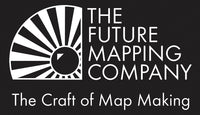Why does our world map look odd?
The story behind map projections
Many people don’t realise how many different map projections there are – there really is no singular view of our world. We’re so used to the traditional world map from our school classrooms (the ubiquitous Mercator projection - more on him later) that we don’t stop to think of how many different ways the world can be projected onto a map. As someone once said, ‘there are no bad projections, just bad uses of projections’.
1. The Earth is round and maps are flat
The Earth is a 3d sphere and a map is a 2d plane so the question is, how do we get from one to the other? Original map projections were literally that – someone held a light up to a globe and drew the image that was ‘projected’ onto paper. The problem is, no matter how you project it, the surface of your sphere gets stretched or you have to cut the paper into different angles, you’ll never end up with perfectly shaped landforms, seas and a perfectly rectangular world map.
The easiest way to understand this is by looking at the pictures below (known as Tissot’s Indicatrix).
2. Distortion is unavoidable
If you project equal circles onto a globe, and then create a 2d map of the same picture you can see how easily the circles get distorted – this is what happens when a map is created.
3. Different map projections are created for different purposes
For a map, the aim is for accuracy and minimal distortion so cartographers have to focus on the intended use of the map and work backwards. If your map is for sailors – the focus will be on longitude and latitude. If the sea and coastline is accurately represented, it doesn’t much matter if the size of the land in between the seas is stretched. If you’re making a thematic map about population sizes, you’ll need accurate country sizes or your information is rendered useless.
All maps are based on measured properties - area, shape, direction, bearings, distances and scale – a cartographer can create a projection that prioritises any of these aspects but not all of them. In addition, there are political or economic reasons as to why the cartographer might want to put their country at the centre of the map – shown here is a Japanese map with the pacific in the centre. Remember if the Earth is a sphere there really is no centre, top or bottom.
4. The world map we are all familiar with, the Mercator Projection, is over 500 years old and created for sailors
One of the best known views of the world is the aforementioned Mercator projection, created by the Flemish cartographer Geradus Mercator in 1569. His projection was designed for navigation as it represented sailing courses of constant bearing as straight lines, but distorted areas and distances.
For many reasons (some political as it showed the European powers at the centre), the Mercator projection became the de-facto map of the classroom. Unfortunately, the map’s distortion means that Africa is shown as the same size as Greenland when it is, in fact, 14 times larger; and Europe is shown the same size as South America when it is only half the size! The distortions are easy to see if you compare it with the true landmass size in this equal area projection - shown below. However, in contrast, in an equal area projection it is the top and bottom that become distorted and stretched.
5. Utilising the Mercator projection as an Educational tool raises problems
There was nothing inherently racist about the Mercator projection when it was created. It simply fulfills the navigational role it was created for. However, when it became an educational tool, it became clear that it had the power to negatively influence perceptions of the poorer countries of the south - "people's ideas of geography is not founded on actual facts but on Mercator's map"1.
Everything you need to know about the unintended social ramifications of the Mercator map are summed up in this clip from The West Wing when CJ receives a visit from the “Organisation of Cartographers for Social Equality” – well worth a watch! Others have tried to address these social issues such as Arno Peters or Buckminster Fuller’s Dymaxion Map – he wanted to avoid cultural bias by creating a map that has ‘no right way up'.
6. The best solution? A general all purpose map, or 'compromise projection'
The best solution for a general, all-purpose map is to use a ‘compromise projection’ - which doesn’t favour one element over another (area, shape, direction etc.) but seeks to compromise a little on all of them to create a coherent and visually pleasing map.
The most well known of these is probably the Robinson Projection, which is what we use for our Classic World Map - shown here.










